6 Best Power Banks for Camping
Sometimes it’s nice to leave technology behind to spend time in nature, but a power bank is a great backup if you need it. Portable chargers allow us to stay connected to the outside world while we’re on the go, and they might even get us out of trouble from time to time.
Videos by Outdoors
The ability to charge a smartphone, a headlamp, or a flashlight is super handy while out camping. So, we did some research and scoped out some of the best power bank options out there for outdoor activities.
There are a lot of factors to consider when purchasing a power bank. In this guide, we will explore the technical requirements, make suggestions for the best products out there today, and answer some frequently asked questions.
Our top pick is the Anker Power Bank 737. A powerhouse of a charger, this one has a massive capacity for all your charging needs and will keep your devices going for days on the road or the trails. Although it’s a little chunky, the slim design is handy for packing away and its power makes it worth the extra weight.
For days out in the wilderness, the Jackery Explorer 240 Portable Power Station is another great investment. Durable and reliable, it’s a wonderful addition to your camping equipment and will be a lifesaver on long trips away from the ordinary.
This post contains affiliate links. Outdoors.com may earn a commission when you make a purchase through these links. Thank you for your support.
The Best Power Banks for Camping in 2024
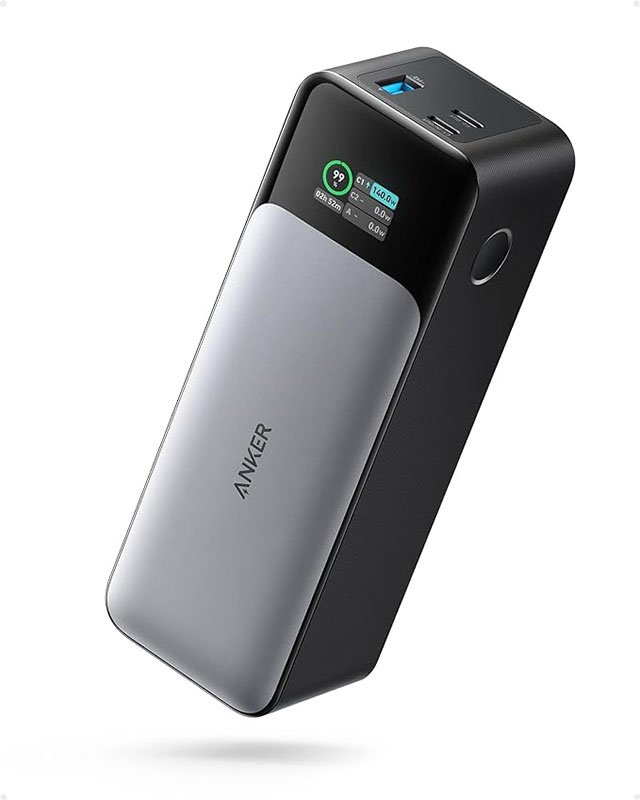
Specs:
- Weight: 1.4 lbs
- Dimensions: 6.13 x 2.15 x 1.95 inches
- Output: 140 watts (W)
- Battery capacity: 24,000 milliamp hours (mAH)
Anker’s 737 Power Bank has massive power. It can literally charge all your devices at super quick speeds, thanks to Anker’s renowned PowerIQ technology.
It can charge a MacBook Pro 16” up to 50% in just 40 minutes. It has high-speed recharging, which, according to Anker, is seven times faster than a standard portable charger.
It is a sturdy and durable piece of gear, with a slim design which makes it portable and easy to fit into a backpack pocket. It has three charging ports (USB C-1, USB C-2 and USB-A) making it compatible with all kinds of devices, including laptops.
The 737 is a one-stop shop for all your charging needs. Even with its huge capacity, it is still within the air travel requirements, so you can take it on the plane.
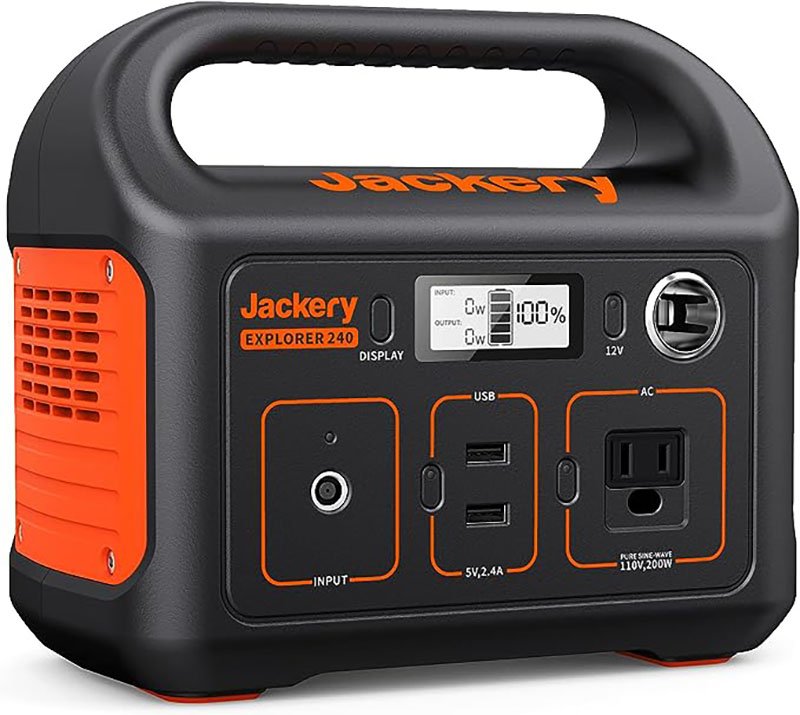
Specs:
- Weight: 0.53 lbs
- Dimensions: 5.68 x 2.63 x0.69 inches
- Output: 18W
- Battery capacity: 10,400 mAh
This lightweight charger from Charmast is another slim design, which can slide into a coat pocket with ease. It comes in several colors and is the perfect travel companion.
It offers quick charging and has six outputs and three inputs, so you can charge several devices at the same time. If you’re lost in the woods and need to check the map, this device will charge your phone in no time and get you back on track. It’s compatible with all phone types.
One of its most unique features is the four built-in cables that neatly snap back into the charger’s body case. This will minimize the need to pack lots of loose cables in your backpack.
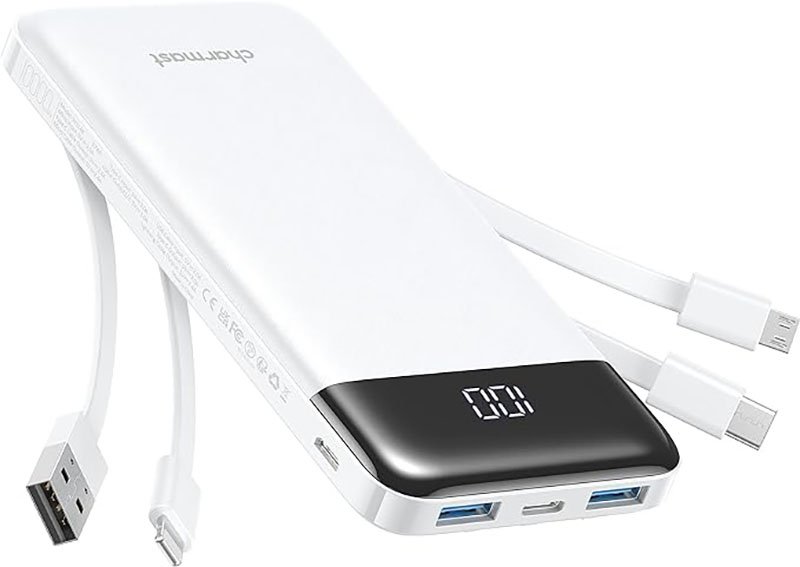
Specs:
- Weight: 6.8 lbs
- Dimensions: 9.1 x 5.2 x 7.9 inches
- Output: 200W
- Battery capacity: 67,000 mAh
This powerful charging station from Jackery might not be the best option for day hikes, but for multi-day camping trips and road trips, it will keep your technology boosted with some of its incredible features. It can also be a handy device to have in the house in case of power outages.
The Jackery Explorer 240 can charge a range of devices, with an AC outlet, two USB-A ports and a DC car port. Its power allows you to charge a drone up to four times, a camera 10 times, a smartphone 24 times, and a laptop three times.
It can be powered entirely by solar. The solar panels, which must be purchased separately, allow the device to charge from direct sunlight in five and a half hours. Or, you can charge it up through a wall outlet or car outlet.
A durable, all-weather product with a useful carrying handle, the Jackery is a reliable addition to your camping gear and will be something you will use in many life scenarios.
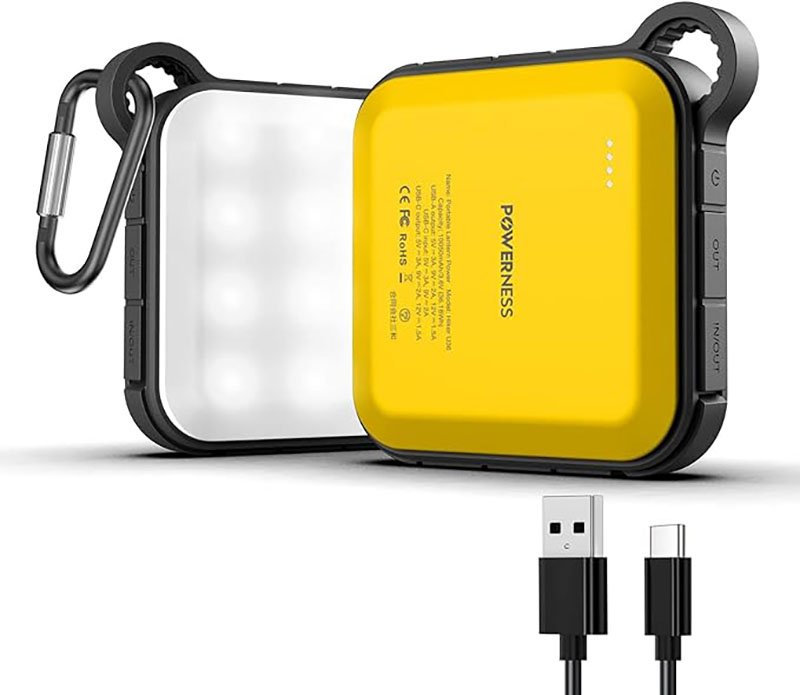
Specs:
- Weight: 3.17 ounces
- Dimensions: 3.74 x 3.74 x 0.98 inches
- Output: 18W
- Battery capacity: 10,050 mAh
This power pack is small but mighty. It provides fast charging for all your devices while you’re on the go. It is designed for off-grid adventures in the outdoors, with a protective casing that provides IP67 waterproof protection and it’s also drop proof up to one meter.
The dustproof casing comes in bright yellow, so it’s easy to spot if you lose it on the trails. It’s compact and fits neatly into a pocket. It comes with a hook, so it can be attached to a backpack or a tent, and it also features an LED light that can last up to 12 hours, and an SOS flashing light for emergencies.
It is compatible with most USB devices and offers fast charging with two USB charging ports, one USB-C, and one micro-USB. It’s available at at full price of $32.99, so it’s another good budget option.
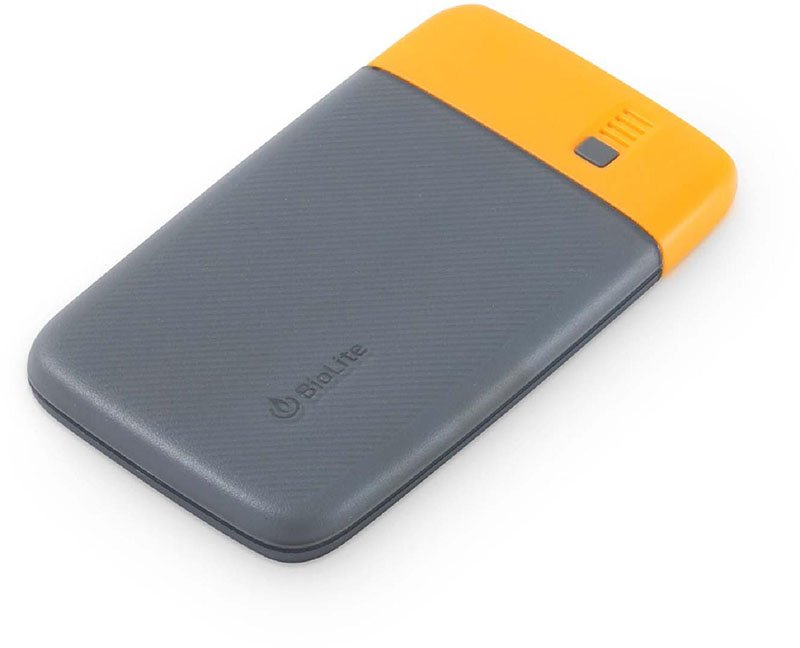
Specs:
- Weight: 5.8 ounces
- Dimensions: 5 x 3 x 0.6 inches
- Output: 18W
- Battery capacity: 6,000 mAh
For a device that will charge up your smartphone, tablet, and other compatible electronics, the BioLite Charge 20 PD is a great choice for quick charging top-ups on the go.
The perfect gadget for hikes, backpacking trips, and outdoor adventures, this charger is easy to use and lightweight, and it can be packed into carry-on luggage.
The device can be charged in two hours and has the power of one-and-half smartphone charges from a full battery. It has three outputs, one USB-C, and two USB-A, with a total output of 18W.
The textured outer material is scratch-resistant, making it easy to grip, and it comes in three slimline sizes with varying levels of power. The Biolite 20 is the smallest of the three.
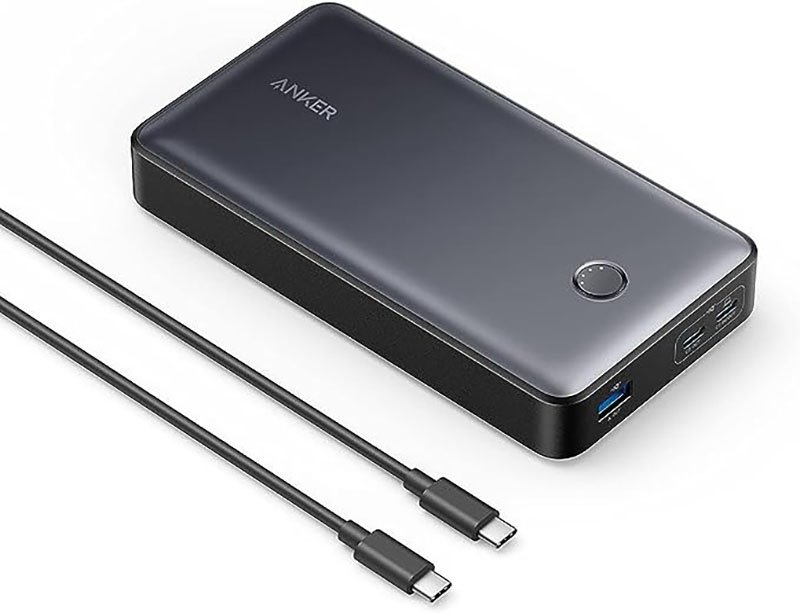
Specs:
- Weight: 1.1 lb
- Dimensions: 6.3 x 3.34 x 1.04 in
- Output: 65W
- Battery capacity: 24,000 mAh
You can always rely on Anker for excellent charging devices. A slim but powerful option is the 537, which has more power than most charging banks on the market at this price. The device has a massive capacity and output, which can even charge a MacBook Pro.
It has a quick recharge time, and it can be ready to go again in just a few hours. It has dual ports so you can power two devices at a time. One of the USB-C ports has a maximum output of 45W, while the other has a maximum output of 20W.
With its smooth finish and sturdy construction, it’s a reliable charger that can be taken on adventurous trips and it will be compatible with all your devices.
How To Find The Right Portable Power Bank
Portable power banks are essential devices, which will save the day on many occasions. Especially if your electronic devices struggle with battery life.
Before you start shopping, there are a few features to look for. For each of the suggestions in this guide, we have noted the weight, dimensions, capacity, and output to help you find the right portable power bank for your needs.
Consider the size and weight of the portable power station to ensure it is suitable for carrying with you on your adventures. This is less of an issue if you will be keeping the power bank in the car, van, or tent.
The battery capacity is measured in milliamp-hours (mAh) and represents the number of charges the device can provide. Look for one with the highest number possible in your budget, from 6,000 mAH and above. Note: the limit to take on airplanes in carry-on luggage is around 27,000 mAH.
The output in watts tells you how fast the charge will be, and how much power the bank has. It is calculated by volts (V) multiplied by amps (A), which equals watts (W). Power stations with a power output of 18W and above will provide fast charging.
Finally, look for the number of ports on the power bank. It’s useful to have several, so you can charge multiple devices at a time. Always check for a USB-C port, as the USB-C cable is the most common charging connector. Other common ones are the USB-A port and micro USB.
What Features to Look For In A Camping Power Bank
Capacity in Milliamp Hours (mAh)
It’s important to check the milliamp-hour (mAh) measurement to check that the battery is sufficient for your needs. A battery with a higher mAh rating will power a device for longer.
For context, an iPhone 15 has a 3,349 mAh battery. Most of the power banks on this list offer 10,000 mAh and above.
Output Ports
The output port allows you to charge your devices. Ensure the power bank has the right types and number of output ports for the devices you use the most.
Common ports include USB-A, USB-C, and micro USB. Always check for USB-C as this is the most common type of connector for today’s technology.
Input Ports
The input ports are responsible for recharging the power bank. USB-C is becoming more popular for both input and output, offering faster charging speeds. Having multiple input options can be convenient.
Output in Watts
Another good indicator of power is the output in watts. This is calculated by volts (V) multiplied by amps (A), which equals watts (W).
For context, a regular wall phone charger has an output of about 10W, a fast phone charger 18W, and a laptop 65W. Higher charging speeds can be advantageous, especially if you have limited time or want to quickly replenish your devices.
Look out for USB Power Delivery (PD), another feature to consider for faster charging.
This is a fast-charging standard that enables higher power levels and dynamic voltage adjustments over USB connections, particularly through USB-C. It provides efficient and versatile charging for multiple devices.
Weight and Size
For camping, you’ll want a portable power station that doesn’t add too much weight to your gear.
If you are spending a long time in the great outdoors, you should prioritize the capacity so your devices can last the trip. If you are doing a shorter trip or a day hike, you will want to consider the size and packability factor of the power bank.
Durability and Build Quality
A durable power bank is essential for outdoor activities. Look out for power banks with additional features like water resistance, shockproof casing, and sturdy construction to withstand the rigors of camping.
Solar-Powered Charging
Some power banks, such as the Jackery, have the option to be charged via solar panels.
Solar power is a renewable and sustainable energy source, which harnesses energy directly from the sun. This means it is virtually inexhaustible, making it an environmentally friendly option for charging electronic devices.
This can be a valuable feature for extended camping trips, allowing you to recharge the power bank using sunlight.
Charge Indicator
A clear and accurate battery level indicator helps you know how much power is left in the power bank at a glance, preventing unexpected outages.
Brands and User Reviews
As with any technology purchase, it’s always wise to consider purchasing from reputable brands. Anker is a mobile technology company that offers a great variety of charging banks at reasonable prices.
When it comes to charging devices, well-respected industry leaders known for their innovation and quality, are usually safe bets. These brands often provide better quality and customer support, too.
Check the number of positive reviews and keep an eye out for any negative experiences with the product.
Budget
The price will vary depending on the power and capacity of the power bank.
A budget power bank with all the important features might cost somewhere between $25 – $40. There will be power banks available for less, but they are unlikely to offer the best charging technology.
For something reliable and long-lasting, you might want to consider spending $50 or more. The Jackery Explorer 240 is the most expensive bank on this list at $220, but it offers a lot of useful features for the price.
Frequently Asked Questions
How do I maintain and extend the lifespan of my power bank?
It’s best to use the power bank regularly to maintain the battery’s health. Do not overcharge the battery, instead keep it charged at around 80%.
Avoid extreme temperatures if possible to prevent damage to the battery. Store it in a cool, dry place and keep it away from heat and sunlight.
What safety features should I look for in a power bank?
Portable power banks undergo a series of tests from manufacturers and testing laboratories to ensure they meet safety standards. Look for a certification from Underwriters Laboratories (UL) or the International Electrotechnical Commission (IEC) to check they are tested and safe to use.
Some of the safety tests that devices will undergo include overcharge protection, short-circuit protection, and temperature control.
What kind of batteries are power banks made from?
Batteries for power banks are usually made from lithium-ion or lithium-polymer. Lithium polymer tends to be more lightweight, while lithium-ion may offer a higher capacity.
Are power banks allowed on airplanes?
Lithion-ion batteries are not allowed in checked luggage, because they can pose a fire risk. However, you can take most power banks in your carry-on luggage.
There is a limit on the capacity of the power bank, which is currently 100 watt hours per battery. This roughly equates to 27,000 mAh.
You can check your battery’s product packaging for the watt-hours. Check the latest airline instructions before you travel, as these are subject to changes.
Final Thoughts
Power banks are an essential item in your camping gear and there are many different options to choose from.
Our advice is to look out for power banks with three key features.
- Check for the battery capacity in (mAh) to see how many charges it can provide.
- Make sure it has fast charging by checking the output in watts (W) or USB Power Delivery.
- Look for multiple ports so you can charge several devices at once.
If you choose a power bank with these features, it will save the day when you’re out in the wilderness and you need to charge your devices.





